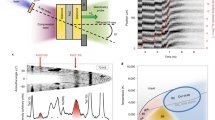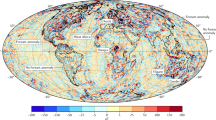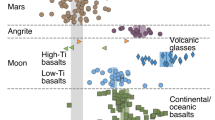Abstract
Understanding the distribution of iron isotopes within planetary bodies can help constrain their histories of accretion and differentiation1,2,3. A large fraction of the iron in the silicate Earth is dissolved in ferropericlase and ferroperovskite—mineral phases that make up the bulk of the lower mantle4. These phases have distinct crystallographic structures and iron resides in them in multiple spin states; they are therefore likely to partition iron isotopes differently. Here we use density functional methods to calculate the equilibrium iron isotope composition of these phases at a range of temperatures and pressures, including those thought to exist near the core–mantle boundary. We find that the iron isotopic composition of ferropericlase strongly depends on the spin state of iron. At pressures near the base of the mantle, the low-spin state is enriched in heavy isotopes relative to the high-spin state. In contrast, for ferroperovskite, our calculations suggest that the isotopic composition is almost independent of spin state. Our results warrant a careful search for a pressure-dependent isotopic signature in samples brought up by mantle plumes and in materials subjected to lower mantle pressures and temperatures in the laboratory.
This is a preview of subscription content, access via your institution
Access options
Subscribe to this journal
Receive 12 print issues and online access
$259.00 per year
only $21.58 per issue
Buy this article
- Purchase on Springer Link
- Instant access to full article PDF
Prices may be subject to local taxes which are calculated during checkout



Similar content being viewed by others
References
Beard, B. L. & Johnson, C. M. Inter-mineral Fe isotope variations in mantle-derived rocks and implications for the Fe geochemical cycle. Geochim. Cosmochim. Acta 68, 4727–4743 (2004).
Weyer, S. et al. Iron isotope fractionation during planetary differentiation. Earth Planet. Sci. Lett. 240, 251–264 (2005).
Poitrasson, F. Does planetary differentiation really fractionate iron isotopes? Earth Planet. Sci. Lett. 256, 484–492 (2007).
Kesson, S. E., FitzGerald, J. D. & Shelley, J. M. Mineralogy and dynamics of a pyrolite lower mantle. Nature 393, 252–255 (1998).
Polyakov, V. B. Equilibrium iron isotope fractionation at core–mantle boundary conditions. Science 323, 912–914 (2009).
Badro, J. et al. Iron partitioning in Earth’s mantle: Toward a deep lower mantle discontinuity. Science 300, 789–791 (2003).
Cohen, R. E., Mazin, I. I. & Isaak, D. G. Magnetic collapse in transition metal oxides at high pressure: Implications for the Earth. Science 275, 654–657 (1997).
Speziale, S. et al. Iron spin transition in Earth’s mantle. Proc. Natl Acad. Sci. 102, 17918–17922 (2005).
Tsuchiya, T., Wentzcovitch, R. M., da Silva, C. R. S. & de Gironcoli, S. Spin transition in magnesiowustite in Earth’s lower mantle. Phys. Rev. Lett. 96, 198501 (2006).
McCammon, C. et al. Stable intermediate-spin ferrous iron in lower-mantle perovskite. Nature Geosci. 1, 684–687 (2008).
Lin, J.-F. et al. Intermediate-spin ferrous iron in lowermost mantle post-perovskite and perovskite. Nature Geosci. 1, 688–691 (2008).
Umemoto, K., Wentzcovitch, R. M., Yu, Y. G. & Requist, R. Spin transition in (Mg,Fe)SiO3 perovskite under pressure. Earth Planet. Sci. Lett. 276, 198–206 (2008).
Stackhouse, S. Mineral physics: The spin deep within. Nature Geosci. 1, 648–650 (2008).
Swart, M. Accurate spin-state energies for iron complexes. J. Chem. Theor. Comput. 4, 2057–2066 (2008).
Bigeleisen, J. & Mayer, M. G. Calculation of equilibrium constants for isotopic exchange. J. Chem. Phys. 15, 261–267 (1947).
Miller, G. H., Stolper, E. M. & Ahrens, T. J. The equation of state of a molten komatiite 2. Application to komatiite petrogenesis and the Hadean mantle. J. Geophys. Res. 96, 11849–11864 (1991).
Stixrude, L. & Karki, B. Structure and freezing of MgSiO3 liquid in Earth’s lower mantle. Science 310, 297–299 (2005).
Sweeney, J. S. & Heinz, D. L. Melting of iron-magnesium-silicate perovskite. Geophys. Res. Lett. 20, 855–858 (1993).
Agnor, C. & Asphaug, E. Accretion efficiency during planetary collisions. Astrophys. J. 613, L157–L160 (2004).
Labrosse, S., Hernlund, J. W. & Coltice, N. A crystallizing dense magma ocean at the base of the Earth’s mantle. Nature 450, 866–869 (2007).
Poitrasson, F., Halliday, A. N., Lee, D.-C., Levasseur, S. & Teutsch, N. Iron isotope differences between Earth, Moon, Mars and Vesta as possible records of contrasted accretion mechanisms. Earth Planet. Sci. Lett. 223, 253–266 (2004).
Schoenberg, R. & von Blanckenburg, F. Modes of planetary-scale Fe isotope fractionation. Earth Planet. Sci. Lett. 252, 342–359 (2006).
Dauphas, N., Craddock, P. R., Bennett, V. & Ohmenstetter, D. The iron isotopic composition of the silicate Earth: Clues from chondrites, peridotites, and eoarchean magmas. Lunar Planet. Sci. Conf. 40, A1769 (2009).
Holzapfel, C., Rubie, D. C., Frost, D. J. & Langenhorst, F. Fe–Mg interdiffusion in (Mg,Fe)SiO3 perovskite and lower mantle reequilibration. Science 309, 1707–1710 (2005).
Kellogg, L. H., Hager, B. H. & van der Hilst, R. D. Compositional stratification in the deep mantle. Science 283, 1881–1884 (1999).
Brandon, A. D., Walker, R. J., Morgan, J. W., Norman, M. D. & Prichard, H. M. Coupled 186Os–187Os evidence for core–mantle interaction. Science 280, 1570–1573 (1998).
Hart, S. R., Hauri, E. H., Oschmann, L. A. & Whitehead, J. A. Mantle plumes and entrainment: Isotopic evidence. Science 256, 517–520 (1992).
Vanpeteghem, C. B. et al. Al, Fe substitution in the MgSiO3 perovskite structure: A single-crystal X-ray diffraction study. Phys. Earth Planet. Inter. 155, 96–103 (2006).
Iitaka, T., Hirose, K., Kawamura, K. & Murakami, M. The elasticity of the MgSiO3 post-perovskite phase in the Earth’s lowermost mantle. Nature 430, 442–445 (2004).
Garai, J. Universal P–V–T equation of state for periclase. Preprint at <http://arxiv.org/abs/0805.0249v1> (2008).
Acknowledgements
This work was financially supported by the US Department of Energy, Division of Basic Energy Sciences, grant DE-FG02-04ER15498 to J.R.R, and NASA Cosmochemistry (NNX08AG57G) and Origins of Solar Systems (NNX09AC93G) grants to Q.-Z.Y. We thank F. Poitrasson for helpful suggestions on the manuscript and V. B. Polyakov for many discussions and sharing his data presented in ref. 5.
Author information
Authors and Affiliations
Contributions
The research problem was identified by Q.-Z.Y. and J.R.R. J.R.R. designed the protocol and carried out the electronic structure calculations. The paper was written by J.R.R. and Q.-Z.Y.
Corresponding authors
Rights and permissions
About this article
Cite this article
Rustad, J., Yin, QZ. Iron isotope fractionation in the Earth’s lower mantle. Nature Geosci 2, 514–518 (2009). https://doi.org/10.1038/ngeo546
Received:
Accepted:
Published:
Issue Date:
DOI: https://doi.org/10.1038/ngeo546
This article is cited by
-
Improved volume variable cluster model method for crystal-lattice optimization: effect on isotope fractionation factor
Geochemical Transactions (2022)
-
Calcium isotope fractionation between aqueous compounds relevant to low-temperature geochemistry, biology and medicine
Scientific Reports (2017)
-
Iron isotopic fractionation between silicate mantle and metallic core at high pressure
Nature Communications (2017)
-
Quantum-mechanical equilibrium isotopic fractionation correction to radiocarbon dating: a theory study
Journal of Radioanalytical and Nuclear Chemistry (2012)



